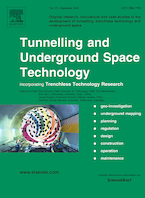-

XXV Congrés Espanyol ITS
Francisco Alonso
(2025). Participació en congressosEl Dr. Francisco Alonso, Director de l'INTRAS, participa al XXV Congrés Espanyol ITS, que se celebra a Madrid del 18 al 20 de febrer de 2025. El Dr. Alonso intervé dins de la Sessió "Projectes Data Space for Mobility (DS4M). Dels NAP als Espais de Dades a la Mobilitat Espanyola". Ponència: El projecte Data Space for Mobility En aquest Congrés, el lema del qual és “Road to ITS Sevilla 2025”, es donaran a conèixer l'abast i contingut d'importants projectes ITS, com són: MOVINN com a Plataforma d'Innovació, SCALE - C-Roads de desplegament de Sistemes Cooperatius i DS4M de Espais de Dades de Mobilitat i impuls dels NAPs.
-

I Trobada de Càtedres Universitàries de Mobilitat Sostenible
Francisco Alonso
(2025). Participació en congressosEl Dr. Francisco Alonso, Director de l'INTRAS, ha participat a la I Trobada de Càtedres Universitàries de Mobilitat Sostenible, que s'ha celebrat a Alacant l'11 de febrer de 2025. La mobilitat està en plena transformació i afronta reptes importants com la sostenibilitat, la descarbonització, els nous hàbits de les noves generacions o la mobilitat compartida i multimodal cada dia més present. Potser per això durant aquests darrers anys cada cop són més les universitats que han incorporat i creat diferents càtedres de reflexió i investigació sobre aquesta matèria. En aquesta I Trobada de Càtedres Universitàries de Mobilitat Sostenible s'han presentat els projectes i treballs més destacats...
El Dr. Francisco Alonso, Director de l'INTRAS, ha participat a la I Trobada de Càtedres Universitàries de Mobilitat Sostenible, que s'ha celebrat a Alacant l'11 de febrer de 2025. La mobilitat està en plena transformació i afronta reptes importants com la sostenibilitat, la descarbonització, els nous hàbits de les noves generacions o la mobilitat compartida i multimodal cada dia més present. Potser per això durant aquests darrers anys cada cop són més les universitats que han incorporat i creat diferents càtedres de reflexió i investigació sobre aquesta matèria. En aquesta I Trobada de Càtedres Universitàries de Mobilitat Sostenible s'han presentat els projectes i treballs més destacats en matèria de mobilitat de les diferents càtedres. El Dr. Alonso va comentar breument la seva experiència a la Càtedra SEOFER de Seguretat Viària i Mobilitat Intel·ligent, a més d'exposar els detalls del nou projecte "ITS DS4M Mediterraneo: Data Space for Mobility", finançat pel Ministeri per a la Transformació Digital i de la Funció Pública a través de la convocatòria "Demostradores y Casos de Uso de Espacios de Datos"
Llegir més Ocultar -

Use of Big Data, Artificial Intelligence and Other Emerging Technologies in Public Health Communication Campaigns: A Systematic Review
Mireia Faus, Francisco Alonso, Cesáreo Fernández, Cristina Esteban
(2025). ArticleReview of Communication Research. Num.13
Introduction: Public health campaigns have begun to employ various emerging technologies such as artificial intelligence (AI) and Big Data for their design, implementation, and evaluation. These technologies offer new opportunities to enhance the effectiveness of health communication strategies by enabling more precise audience segmentation, personalized messaging, and real-time impact assessment. However, despite their potential, their application in public health campaigns remains a relatively new field of study. This systematic review aims to identify and analyze the scientific literature that examines the role of these tools in optimizing communication strategies aimed at promoting...
Introduction: Public health campaigns have begun to employ various emerging technologies such as artificial intelligence (AI) and Big Data for their design, implementation, and evaluation. These technologies offer new opportunities to enhance the effectiveness of health communication strategies by enabling more precise audience segmentation, personalized messaging, and real-time impact assessment. However, despite their potential, their application in public health campaigns remains a relatively new field of study. This systematic review aims to identify and analyze the scientific literature that examines the role of these tools in optimizing communication strategies aimed at promoting healthy behaviors and attitudes among the population. Methods: Following the PRISMA methodology, 129 potentially relevant articles were initially identified from the search in the WOS, Scopus and PubMed databases. However, only 18 met the established inclusion criteria. Results: We identified a scarcity of scientific articles focused on presenting findings on the application of emerging technologies in public health campaigns. Most of the research focused on the use of these tools for audience segmentation and impact assessment, while their use in campaign design was a minority. Conclusions: This study supports the usefulness of the application of these technologies at any stage of the campaign implementation process, and presents some limitations that can help optimize this approach and improve the reach and effectiveness of public health communication strategies.
Llegir més Ocultar DOI: 10.52152/RCR.V13.3 -

Traffic safety improvement method for highway tunnel entrances based on linear guiding − An engineering practice from China
Yongzheng Yang, Zhigang Du, Francisco Alonso, Mireia Faus, Hongliang Wan
(2025). ArticleTunnelling and Underground Space Technology. Num.156:106267
To improve traffic safety at the entrance of highway tunnels, a comparative analysis of the traffic environment inside and outside the tunnel was conducted, and an improvement scheme based on “linear visual guiding” was developed by considering the human factors. Before and after the improvement of nine experimental tunnels, two batches of vehicle experiments were conducted to analyze the improvement effect of linear guiding scheme on traffic safety. The results show that the linear guiding scheme warns drivers and enables them to make preparations to enter the tunnel earlier. After improvement, the starting position for deceleration (SPD) was 61%earlier and the length of the deceleration...
To improve traffic safety at the entrance of highway tunnels, a comparative analysis of the traffic environment inside and outside the tunnel was conducted, and an improvement scheme based on “linear visual guiding” was developed by considering the human factors. Before and after the improvement of nine experimental tunnels, two batches of vehicle experiments were conducted to analyze the improvement effect of linear guiding scheme on traffic safety. The results show that the linear guiding scheme warns drivers and enables them to make preparations to enter the tunnel earlier. After improvement, the starting position for deceleration (SPD) was 61%earlier and the length of the deceleration section (LDS) has increased by 42%; the starting position for trajectory change (SPTC) was 153% earlier and the length of the trajectory change section (LTCS) has increased by 44%.The improved deceleration and trajectory change are earlier and smoother, and the dramatic changes in speed and trajectory in the tunnel entrance are resolved. When entering the tunnel, drivers sequentially complete deceleration, vehicle trajectory adjustment, and visual adaptation to black-hole effect, disperses driving tasks, reducing the coupling of driving risks. And use linear guiding facilities to enhance the local brightness of the tunnel, enhancing the driver’s visual perception ability in the black-hole effect area. Linear guiding scheme has good results during day, night, and fog, and is able to improve traffic safety at tunnel entrances in all-weather and multiple time periods
Llegir més Ocultar DOI: 10.1016/j.tust.2024.106267ISSN: 1878-4364 -

Road safety compliance and enforcement: insights from user perceptions in Spain and the Dominican Republic
Francisco Alonso, Mireia Faus, Cristina Esteban, Sergio Useche
(2025). ArticleRevista Logos Guardia Civil. Num.4
Regulations, the sanctioning system, and police supervision are among the main components for increasing road safety. In fact, most accidents are caused by non-compliance with the rules, and it is precisely the elimination and deterrence of these offending behaviors that must be based on an effective sanctioning system supported by the corresponding police supervision. This paper discusses some of the principles that enforcement must comply with in order to maximize its usefulness. To this end, this paper presents a series of empirical data from our own research, through surveys of the population (in Spain and the Dominican Republic), on the degree of knowledge of traffic regulations, the...
Regulations, the sanctioning system, and police supervision are among the main components for increasing road safety. In fact, most accidents are caused by non-compliance with the rules, and it is precisely the elimination and deterrence of these offending behaviors that must be based on an effective sanctioning system supported by the corresponding police supervision. This paper discusses some of the principles that enforcement must comply with in order to maximize its usefulness. To this end, this paper presents a series of empirical data from our own research, through surveys of the population (in Spain and the Dominican Republic), on the degree of knowledge of traffic regulations, the motivations that lead to compliance/non-compliance, as well as the penalties associated with non-compliance, the attributed and real probability of being sanctioned, and their assessment of the whole system, including the attribution of effectiveness. Finally, the aforementioned evidence is compared with key principles of learning and behavior (especially punishment), to see to what extent they correspond, thus drawing some conclusions about the common existing deficits in the reality of enforcement systems in many countries, which present an opportunity for improvement.
Llegir més Ocultar -

Assessing the impact of point-based license systems on road safety: A systematic review and meta-analysis
Francisco Alonso, Mireia Faus, Cristina Esteban, Bosco Martí
(2025). ArticleThe European Journal of Psychology Applied to Legal Context. Num.17
Background: The driver’s license point-based system is a preventive measure for penalizing offenses committed by drivers with the aim of reducing road accidents, which has been applied in a large number of countries to date. The aim of this systematic review was to examine a set of studies that analyze the effectiveness of point-based licensing in relation to the reduction of road accidents, as well as its impact on other variables documented in the scientific literature. Method: In this systematic review and meta-analysis, we searched PubMed, Scopus, and Web of Science for reports published between date of database inception and September 2023. The review process was conducted following...
Background: The driver’s license point-based system is a preventive measure for penalizing offenses committed by drivers with the aim of reducing road accidents, which has been applied in a large number of countries to date. The aim of this systematic review was to examine a set of studies that analyze the effectiveness of point-based licensing in relation to the reduction of road accidents, as well as its impact on other variables documented in the scientific literature. Method: In this systematic review and meta-analysis, we searched PubMed, Scopus, and Web of Science for reports published between date of database inception and September 2023. The review process was conducted following the PRISMA recommendations and requirements. This procedure acquired 26 items that met the eligibility requirements of the study. Results: It is noted that point-based driving licenses are beneficial for road safety as they discourage drivers from committing infractions or risky behaviors and, consequently, contribute significantly to reducing road accident rates in the regions where they are applied. Specifically, meta-analysis indicate that point-based driving license reduced, as an overall, around 21% the negative outcomes related to traffic, 10% fatalities, and 9% non-fatal injuries. In addition, it is identified that users value the measure positively, and perceive that its purpose is to raise awareness and improve road safety, rather than its sanctioning or collecting role. Conclusions: The findings support the implementation and expansion of the point-based license system in more countries around the world as a valuable strategy to reduce traffic accidents and promote a safer driving culture.
Llegir més Ocultar DOI: 10.5093/ejpalc2025a2 -

1st International Congress for Road Safety and Security Equipment
Francisco Alonso, Mireia Faus, Cristina Esteban, Sergio Useche
(2025). Participació en congressosEl Dr. Francisco Alonso, Director de l'INTRAS, ha participat al 1st International Congress for Road Safety and Security Equipment, que se ha celebrat el 18 i 19 de gener de 2025 a Benghazi, Líbia. El Dr. Alonso ha presentat la ponència "Best Law Enforcement Practice for Road Safety: Implementing Point-Based Driving License Systems" els coautors de la qual són Mireia Faus, Cristina Esteban i Sergio Useche. El congrés se ha celebrat en el marc del Pla Mundial de les Nacions Unides per a la Segona Dècada d'Acció per a la Seguretat Viària (2021-2030) després de la Declaració de Brasília per assolir l'Objectiu de Desenvolupament Sostenible 3.6 de reduir a la meitat el nombre de morts i ferits...
El Dr. Francisco Alonso, Director de l'INTRAS, ha participat al 1st International Congress for Road Safety and Security Equipment, que se ha celebrat el 18 i 19 de gener de 2025 a Benghazi, Líbia. El Dr. Alonso ha presentat la ponència "Best Law Enforcement Practice for Road Safety: Implementing Point-Based Driving License Systems" els coautors de la qual són Mireia Faus, Cristina Esteban i Sergio Useche. El congrés se ha celebrat en el marc del Pla Mundial de les Nacions Unides per a la Segona Dècada d'Acció per a la Seguretat Viària (2021-2030) després de la Declaració de Brasília per assolir l'Objectiu de Desenvolupament Sostenible 3.6 de reduir a la meitat el nombre de morts i ferits per accidents de trànsit al món per al 2030. L'acte, titulat "Governance and Management of Road Safety in Libya: Reality and Challenges", va comptar amb el suport de destacades institucions líbies, com el Cap de l'Estat Major de les Forces Terrestres, el Ministeri de l'Interior i la Cambra de Comerç i Indústria de Bengasi, i amb el suport addicional dels Ministeris d'Afers Estrangers i Sanitat.
Llegir més Ocultar -

Primera Reunió Regional per a Amèrica Llatina
Francisco Alonso
(2024). Participació en congressosEl Dr. Francisco Alonso, Director de l'INTRAS, ha participat a la Primera Reunió Regional per a Amèrica Llatina celebrada del 5 al 7 de novembre de 2024 a Mèxic. El Dr. Alonso va parlar de l'estudi de “Llicència per punts” treballat juntament amb la Fundació Aleàtica, generant un workshop sobre la importància de la llicència de conduir per punts. Organitzada per la Global Alliance of NGO for Road Safety, la Reunió ha pretès abordar els temes més urgents i crítics que enfronta la comunitat de seguretat viària a Amèrica Llatina El seu objectiu és reforçar i millorar la xarxa de l'Aliança i el capítol regional per facilitar una acció enèrgica i mobilitzar les ONG per reclamar a la propera...
El Dr. Francisco Alonso, Director de l'INTRAS, ha participat a la Primera Reunió Regional per a Amèrica Llatina celebrada del 5 al 7 de novembre de 2024 a Mèxic. El Dr. Alonso va parlar de l'estudi de “Llicència per punts” treballat juntament amb la Fundació Aleàtica, generant un workshop sobre la importància de la llicència de conduir per punts. Organitzada per la Global Alliance of NGO for Road Safety, la Reunió ha pretès abordar els temes més urgents i crítics que enfronta la comunitat de seguretat viària a Amèrica Llatina El seu objectiu és reforçar i millorar la xarxa de l'Aliança i el capítol regional per facilitar una acció enèrgica i mobilitzar les ONG per reclamar a la propera Conferència Ministerial Mundial que s'assigni una inversió adequada per posar en pràctica intervencions centrades en les persones i basades en evidència per salvar vides.
Llegir més Ocultar -

ICSC 2024
Sergio Useche, Oscar Oviedo-Trespalacios, Francisco Alonso
(2024). Participació en congressosWhat do European cyclists think about Advanced Cyclist Assistance Systems (ACAS) and their features? Investigadors de l'INTRAS participen al 12th International Cycling Safety Conference, que se celebra del 5 al 7 de novembre de 2024 a Imabari (Japó) La missió de la comunitat International Cycling Safety (ICS) és millorar la seguretat ciclista a través del treball científic. La comunitat ICS pretén difondre els resultats científics a totes les parts interessades a la seguretat ciclista. Les conferències anuals de l'ICS ofereixen un fòrum de primer ordre per compartir resultats científics i afavorir la creació de xarxes dins de la comunitat ICS. Tema de l'ICSC 2024: Cultura de la...
What do European cyclists think about Advanced Cyclist Assistance Systems (ACAS) and their features? Investigadors de l'INTRAS participen al 12th International Cycling Safety Conference, que se celebra del 5 al 7 de novembre de 2024 a Imabari (Japó) La missió de la comunitat International Cycling Safety (ICS) és millorar la seguretat ciclista a través del treball científic. La comunitat ICS pretén difondre els resultats científics a totes les parts interessades a la seguretat ciclista. Les conferències anuals de l'ICS ofereixen un fòrum de primer ordre per compartir resultats científics i afavorir la creació de xarxes dins de la comunitat ICS. Tema de l'ICSC 2024: Cultura de la seguretat ciclista Fins ara, hi ha un interès cada vegada més gran en la investigació, des del nivell polític fins al de la carretera i el carrer, sobre la qüestió de com aconseguir un ús segur de la bicicleta a la societat. Els debats sobre aquest tipus de recerca se centren en la definició de la cultura de seguretat ciclista, exploren el comportament dels usuaris de la via pública i les activitats de les persones i organitzacions implicades en la seguretat viària, i inclouen un debat permanent sobre com poden contribuir els investigadors de tot el món a la seguretat ciclista. Per tant, en centrar-se en la cultura de la seguretat ciclista, la conferència espera brindar l'oportunitat de conèixer millor l'estat de la seguretat ciclista al món i fomentar la col·laboració internacional entre investigadors per reduir els accidents i lesions amb bicicleta.
Llegir més Ocultar -

ICSC 2024
Sergio Useche, Oscar Oviedo-Trespalacios, Francisco Alonso
(2024). Participació en congressosWorkshop "Moving from the present to the future: upcoming issues, methods and challenges in cycling safety research" Investigadors de l'INTRAS participen al 12th International Cycling Safety Conference, que se celebra del 5 al 7 de novembre de 2024 a Imabari (Japó) La missió de la comunitat International Cycling Safety (ICS) és millorar la seguretat ciclista a través del treball científic. La comunitat ICS pretén difondre els resultats científics a totes les parts interessades a la seguretat ciclista. Les conferències anuals de l'ICS ofereixen un fòrum de primer ordre per compartir resultats científics i afavorir la creació de xarxes dins de la comunitat ICS. Tema de l'ICSC 2024: Cultura...
Workshop "Moving from the present to the future: upcoming issues, methods and challenges in cycling safety research" Investigadors de l'INTRAS participen al 12th International Cycling Safety Conference, que se celebra del 5 al 7 de novembre de 2024 a Imabari (Japó) La missió de la comunitat International Cycling Safety (ICS) és millorar la seguretat ciclista a través del treball científic. La comunitat ICS pretén difondre els resultats científics a totes les parts interessades a la seguretat ciclista. Les conferències anuals de l'ICS ofereixen un fòrum de primer ordre per compartir resultats científics i afavorir la creació de xarxes dins de la comunitat ICS. Tema de l'ICSC 2024: Cultura de la seguretat ciclista Fins ara, hi ha un interès cada vegada més gran en la investigació, des del nivell polític fins al de la carretera i el carrer, sobre la qüestió de com aconseguir un ús segur de la bicicleta a la societat. Els debats sobre aquest tipus de recerca se centren en la definició de la cultura de seguretat ciclista, exploren el comportament dels usuaris de la via pública i les activitats de les persones i organitzacions implicades en la seguretat viària, i inclouen un debat permanent sobre com poden contribuir els investigadors de tot el món a la seguretat ciclista. Per tant, en centrar-se en la cultura de la seguretat ciclista, la conferència espera brindar l'oportunitat de conèixer millor l'estat de la seguretat ciclista al món i fomentar la col·laboració internacional entre investigadors per reduir els accidents i lesions amb bicicleta.
Llegir més Ocultar









